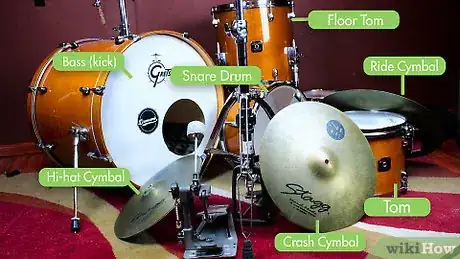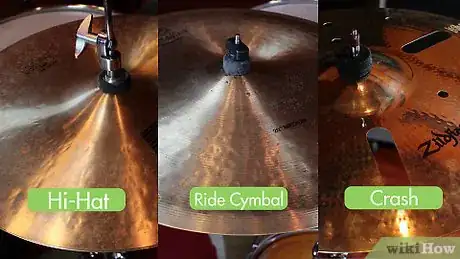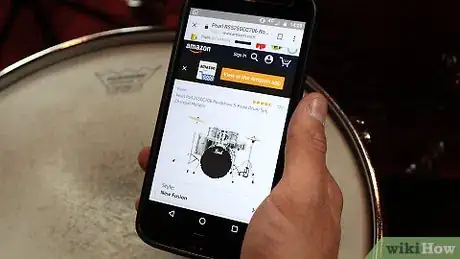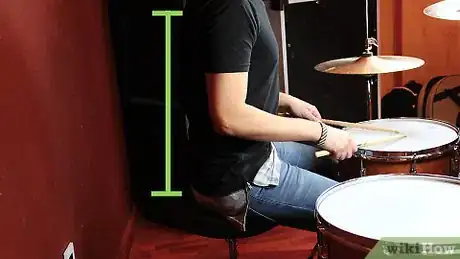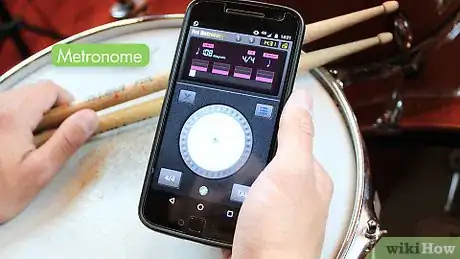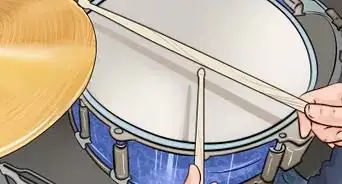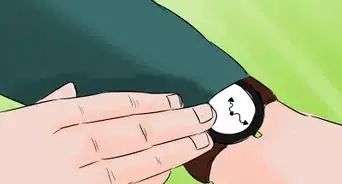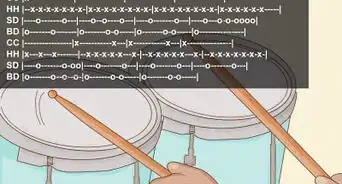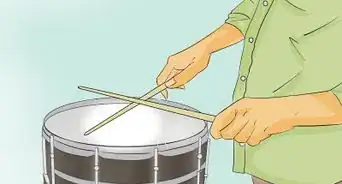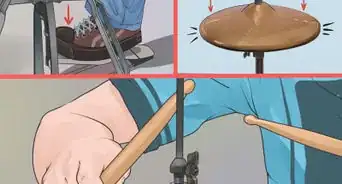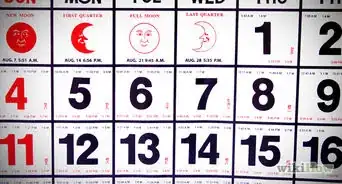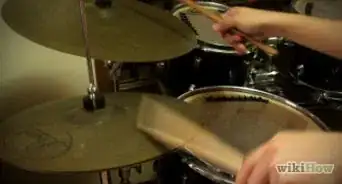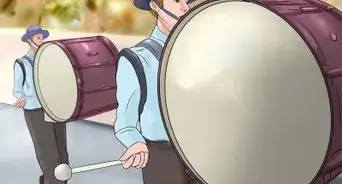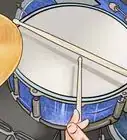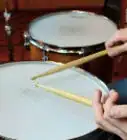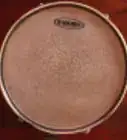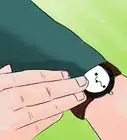wikiHow is a “wiki,” similar to Wikipedia, which means that many of our articles are co-written by multiple authors. To create this article, 128 people, some anonymous, worked to edit and improve it over time.
wikiHow marks an article as reader-approved once it receives enough positive feedback. This article has 17 testimonials from our readers, earning it our reader-approved status.
This article has been viewed 1,282,415 times.
Learn more...
Drummers are in high demand. One of the most popular instruments in the world, the basic drum techniques and skills can be learned in an afternoon, but can take months or years of practice and dedication to master. With time and practice habits, you can learn rhythm and fundamentals, eventually working more complex rhythms and patterns into your drumming. See Step 1 for more information.
Steps
Getting Familiar with the Instrument
-
1Get familiar with the basic drum kit. Each kit is different, using different kinds of drums that make up a set. There are different brands, sizes, sticks used, and different tunings among other slighter modifications that will affect the overall sound of each instrument. Still, many drum kits employ basically the same fundamental pieces. Most basic kits include:
- A bass drum, which makes the low-pitched booming sound when struck by a weighted mallet operated by a foot pedal.
- A snare drum, usually located to the non-dominant side of the drummer and played with the drummer's non-dominant stick. The snare is a tight, bright drum with a band of rattling metal beads under the drum head. Typically, the snare is known for its crisp "click" sound followed by the "resonating shuffle" of the beads.
- There are many types of tom-tom drums, but the most common three are the Floor Tom (the deepest of the three), the Mid-Tom (the medium of the three), and the High-Tom (the most high-pitched of the three). A very basic kit may only have the floor tom, while others may have many. They're tuned differently to create an array of different deeper noises for fills.
-
2Learn the different kinds of cymbals. There are many different kinds of cymbals, varying in type, shape, and sound. A cymbal is a round, metal object that resonates when struck. The four most commonly used types of cymbals are the hi-hat, the ride, the splash, and the crash.[1]
- The hi-hat is a pair of cymbals mounted on a foot pedal. The foot pedal is usually played by the left foot and controls the cymbals, bringing them together when pressed and bringing them apart when released. You can strike the cymbal when it is apart or closed, and you can shut the cymbals with your feet at different rates of speed, each creating a different sound.
- The ride cymbal creates a more subtle and deeper sound than the other cymbals because it is used to play very repetitively throughout most music. The cymbal will usually resonate from one strike to another, featuring a very long reverberating "finish" to the sound.
- The splash is a cymbal that creates a metallic "splashing" sound, similar to the sound a water splash makes. It dies quickly after peaking and is typically used in basic fills to ornament your beat.
- The crash is similar to the splash, but usually generates a loud and long, sustained sound. Listen for the crash at the end of measures in pop music or especially in periods of heightened drama in orchestral music.
Advertisement -
3Get comfortable holding the drum sticks. There are two main ways to hold drum sticks, called the matched grip and the traditional grip.[2]
- In the matched grip, you hold the sticks between your thumb and index finger a few inches from the bottom of the sticks. Wrap your remaining fingers around the sticks. Be sure the back side of your hands are facing up rather than facing to the side. This method is the most common way of holding sticks, allowing you plenty of wrist control and comfort.
- In the traditional grip, you'll hold the stick in your non-dominant hand by resting the stick in the cradle between your thumb and index finger and on top of your ring finger. Wrap your thumb, index and middle fingers around the stick. Hold the other stick using a matched grip. Some jazz drummers use a traditional grip to offer a different kind of control on the snare drum, playing intricate rhythms on it as part of fills.
-
4Research starter kits. If you are interested in drumming, price many different new and used options before you spend the money on a set. Talk to the people at the stores and they should steer you in the right direction. Start out with a cheap, new set or a used set until you finally decide if you are going to stick with it.
- You can also consider joining your school band to have access to the equipment and lessons to help you learn. You might even ask in your band department if you'd be allowed to practice a few times on a kit because you're interested in the drums. The music folk are generally friendly people, and it can't hurt to ask.
-
5Try a variety of drumsticks. There are a lot out there, but there is no right or wrong stick. 5A is a good stick weight for beginners.
- Have your drum teacher or the people at the store give you some pointers on how to hold the sticks, how to hit the drum properly, how to adjust the drums to fit your stature, and how to set up your kit at home. You can also find a lot of this information for free on the internet.
-
6Learn to sit at the kit with the proper posture. Good posture will make you more comfortable during practice and help you reach the drums more easily. You'll sound better and enjoy playing more by improving your posture.
- Sit up straight and keep your elbows in. Stay in tight to the kit, keeping the floor pedals at a comfortable distance from you.
Learning Rhythm
-
1Start learning to drum with your hands. You don't have to have a monstrous kit with a gong like Neil Peart from Rush to get started drumming. You don't even have to have a kit at all. To get started on the basics, use your hands and tops of your thighs in a seated position to learn basic drum-kit rhythms. Listen to music with obvious rhythms and try to mock the rhythm with your hands.
- Many beginners can get frustrated upon plopping down behind a kit and not being able to play a simple rhythm yet. It's a good idea to start getting some sense of rhythm before dropping the cash on a big drum kit to practice on, or before giving yourself an opportunity to get frustrated.
-
2Learn to count quarter notes. There are many ways to break down a a musical bar, but for the purposes of getting started, we'll discuss 4/4 time signature, meaning that there are 4 beats in a measure. Tap out 4 equal beats with one hand. These are quarter notes.
- Count out loud when you're just getting started. It's important to keep track of the rhythm and learn what you're playing, allowing you to develop more complex awareness of beat.
- It's a good idea to use a metronome or a click track to practice rhythms. They're easy to find online, in GarageBand, or on your phone, or by playing along to songs.
-
3Learn to count eighth notes. Each quarter note is made up of two eighth notes. Keep tapping that simple quarter note beat with one hand and then try eighth notes at the same beat. These are counted "1-and-2-and-3-and-4-and..." Try your best to say it steadily and beat it with your hand.
-
4Work in your other hand. Continue with your first hand, counting out eighth notes. Now, whenever you say "Two" and "Four," tap the table or the top of your thigh with your other hand. This fills in where you'll be hitting the snare when you sit behind a kit.
-
5Work in the downbeat. Continue tapping with both hands, but now whenever you say "One" or "Three", tap your right (or left) foot. This is called the downbeat, and is what you'll tap out on the bass drum.
- You're playing a simple rock-style drum beat! Learning drums is broken into two big categories of things you need to learn: rhythm and technique. You can't learn technique without a drum kit, but you can learn about rhythm. By learning everything you can about rhythms and developing your sense of keeping a beat and counting before you ever sit behind a drum kit, you'll be a better drummer and be able to learn more quickly.
Practicing Properly
-
1Buy a metronome. This can't be stressed enough: you need to learn to play a steady, even tempo and the easiest way to beat that into your brain is by practicing with a metronome. If you can't afford a metronome, you can find a click track somewhere which is a recorded metronome that you can play in your stereo, on your Walkman, or on your computer while you practice.[3]
-
2Play your simple hand beat on the kit. Play the 8th notes on the hi-hat, hitting the snare drum on 2 and 4, and pressing the bass drum pedal with your foot on the 1 and 3.
- Make sure you count out loud when you are playing. Eventually you won't have to, but do it while you are learning and when you are practicing.
- To mix it up and get familiar with the kit, hit something else on the "Two" and on the "Four" instead of the snare drum, hit everywhere else.
- Try to develop a groove and get used to playing evenly, while counting out loud and while playing with the click.
-
3Work in the hi-hat foot pedal. Learn how to close the hi-hat with the left foot when you strike it with your hands. It makes a different, shorter sound. This is the position at which most drummers use the hi-hat most frequently.
- Play straight eighth notes with the right hand. Use the left hand and hit the snare on "Two" and "Four". Lift your foot off of the hi-hat here and there to get used to the sounds you are making. You can open it all the way, open it a little and hit the hi-hat in different places such as the outside rim, or the bell at the top to get different sounds.
-
4Develop your footwork. At the same time you hit the hi-hat, learn to work in bass drum rhythms to help develop the muscles.
- Try to play with the right hand and foot at the same time, left hand free styling, or with all limbs at the same time to really get your muscles used to moving.
-
5Start switching it up. Play the same thing above, but instead of hitting the snare on the "Two" and "Four" hit the hi-hat. When you are lifting your right hand off the hi-hat move your left hand down to hit the snare. Now you are basically playing the snare drum in between each hit of the hi-hat.
- While you are doing this count out loud "One e and a Two e and a Three e and a Four e and a" continuing to hit the hi-hat with the right hand on the "One and Two and Three and Four and" but hitting the snare on the "es and as."
-
6Relax during practice. If you notice any tension, or you're struggling to keep up with the beats at the RPM you've set the metronome at, slow down the metronome until you feel relaxed.[4]
Learning Limb Independence
-
1Learn your snare drum rudiments. The basic "single" stroke and a "double" stroke are absolutely essential to developing your limb independence and drum complexity. If you strike the drum with one beat from each alternating hand, you have a single stroke pattern. However, if you strike the drum with one downward movement from each alternating hand and let the stick bounce on each alternating stroke to get two hits per stroke, you have a double stroke pattern.[5]
- This is what enables a drummer to perform very fast rolls and patterns. By studying and practicing the 26 American drum rudiments, you will be well on your way to mastering single, double, triple and quadruple stroke patterns.
-
2Incorporate both feet. It can be a bit like rubbing your belly and patting your head, but learning drums means that you've eventually got to do more complicated things all at once. Instead of making one movement up and one movement down you may have to double or triple or even quadruple one movement with a limb while the other limbs do something else in another direction.
- Count the same beat you've been using so far with eighth notes, and on every beat close the hi-hat with your left foot and open it on the offbeats, or "ands". Hit the snare drum on the twos and fours to make a basic rock beat. With your right hand keep 8th note time (one and two and three and four and) on the rim of the snare or on a ride cymbal if you have one.
-
3Try to play the kick drum with the right foot. Experiment with various beats with the right foot while keeping the rest of the limbs locked in the main pattern. This is where it starts to get tricky. Don't worry though, it gets easier the more you play. You have to get your limbs used to making movements that are independent of each other. There is no quick way to do this. Just take your time and think about what you are doing. If you break it down into one beat at a time it makes things a lot easier.
Learning More Complex Rhythms
-
1Learn triplets. For quarter note triplets you must think in terms of half notes. Count 1-la-le evenly in the space of the half note. For eighth note triplets it's the same, but with three notes split in the space of a quarter note.
- Triplets are not used that much in rock beats but you will find them in drum fills and used in percussion lines found in school bands. Basically a triplet is where you play 3 notes in the time you usually play 2. you can have quarter note triplets, 8th note triplets, 16th note triplets, 32nd note triplets.
- We have a cool sounding beat with 8th note triplets. They are counted "[One-Trip-Let][Two-Trip-Let][Three-Trip-Let][Four-Trip-Let]" or any three syllable word. Play this along with the metronome each click on the metronome is a beat and each beat is subdivided.
-
2Learn 16th notes. 16th notes are basically what you played earlier when you were learning to move your hands in opposite directions. These are counted "[1 e + a] [2 e + a] [3 e + a] [4 e + a]"
- 16th note triplets are counted [1 trip let and trip let] [2 trip let and trip let] [3 trip let and trip let] [4 trip let and trip let]
-
3Learn 32nds. 32nd notes should be counted "[1 e + a + e + a] [2 e + a + e + a] [3 e + a + e + a] [4 e + a + e + a}
- There are 32nd note triplets that require a lot of subdivision to count and are pretty much too fast to say out loud, but if you want to hear some 32nd notes and 32nd not triplets, then listen to the song "Hey Joe" by Jimi Hendrix. These notes are hard to play correctly because you need to be able to play them evenly, making the same sound on the drums with each hand and be able to move around the drum kit playing these notes in time with the rest of the song.
-
4Remember that each of the subdivisions has to fit in time with the metronome. Each click will be quarter beat and easy to keep time by the time you get to the higher subdivisions you will be counting faster or playing faster but the numbers you say will always land on the clicks of the metronome.
-
5Use rests within the song where no sound is made during the note. Listen to some of your favorite songs and use a small subdivision such as the 8th or 16th note count and you will see that during a lot of the fills you will hear spaces where there is silence when you are counting. These are the rests.
-
6Learn how to subdivide beats and rests through practice with just the snare drum. Your goal is to be able to make even sounds with both hands. When you play an accented note with the right hand it should sound the same when you play with the left and when you make a normal stroke with the right it will sound the same as the left and vice versa and so on.
- An accented stroke is when you strike the drum harder than the other strokes (usually on the rim of the drum, also known as a rimshot). Accents give a very dynamic effect to the music. In music notation, accents are shown by the mathematical "greater than" sign (>).
Playing Fills
-
1Use fills to add to the song you're playing. The purpose of a drum fill is to add a little flair to a song. A guitar player plays a hot little lick and a singer might shout and dance about, and the drummer plays fills. These happen in time between the beats, usually on the toms and the cymbals. Listen to John Bonham to hear the master of drum fills.
-
2Start with the basic beat. Play "1 + 2 + 3 + 4 +" and play as you did before with right hand on the hi-hat and left on the snare. Use the right foot on the kick. Repeat as you warm up. Now continue counting out loud and just play "1 + 2 +" and then stop playing with your limbs and just finish counting out loud "3 + 4 +"repeat.
- It should sound like "Boom tic Pap tic" now on the "3 + 4 +" do anything else for example start with moving every limb at the same time on the "3 + 4 +" you can hit the crash (if you have one) on the one on the following bar and you will have pulled off your first fill.
-
3Be creative. Do every combination and variation on this basic theme, while counting the "3 + 4 +". Some will sound good to you some won't. Some basic ones can be all snare alternating hands. Two kick and then two snares. Two snares and two kicks. As long as you keep the time it doesn't matter what you pick as long as the time stays even.
-
4Play more complex fills. Continue to play the "1 + 2 +" as you did above. Now pick a couple subdivisions of the beat as written out between the brackets above for the "3" beat and the "4" beat" such as "[3 trip let] [4 e + a} play note while counting out loud and use all limbs at the same time as you did above.
- Now pick other subdivisions for the "3" and 4" beat you can go "[3 +] [4]" or "[3 +] [4 trip let]" or "[3 e + a] [4 +]" or whatever. Is it starting to get easier yet? As long as the notes are played evenly and within the time you have lots and lots of possible combinations for the fills.
- You don't have to just play the [3] beat and [4] beat as fills. You can play the whole bar as a fill picking any of the subdivisions for each beat and combining them such as "[1 e + a] [2 trip let] [3 +] [4 trip let]" or whatever you picked. Say the subdivisions out loud then play with all limbs and then play around with using different sounds and sound combinations for the subdivisions.
-
5Use your fills wisely. Learn to hold back on fills, even if you're a killer drummer. AC/DC songs feature extremely simple fills or no fills at all, which fits in perfectly with their no-frills reputation as a band. It would sound ridiculous if "Back in Black" featured a drum solo.
- You don't have to start a fill at the beginning of a beat. Count " One and Two" and play it like you did before with the right hand on the hi-hat and the left on the snare but when you get to the "and three and four and" play the fill starting on that and instead of waiting for the "three" beat.
Community Q&A
-
QuestionHow do you hold a drumstick?
 wikiHow Staff EditorThis answer was written by one of our trained team of researchers who validated it for accuracy and comprehensiveness.
wikiHow Staff EditorThis answer was written by one of our trained team of researchers who validated it for accuracy and comprehensiveness.
Staff Answer wikiHow Staff EditorStaff AnswerThere's more than one way to hold a drumstick, so take a look at How to Hold a Drumstick for the most common grips.
wikiHow Staff EditorStaff AnswerThere's more than one way to hold a drumstick, so take a look at How to Hold a Drumstick for the most common grips. -
QuestionHow much is a set of drums?
 wikiHow Staff EditorThis answer was written by one of our trained team of researchers who validated it for accuracy and comprehensiveness.
wikiHow Staff EditorThis answer was written by one of our trained team of researchers who validated it for accuracy and comprehensiveness.
Staff Answer wikiHow Staff EditorStaff AnswerDrum sets vary widely in price. Kits for complete beginners or children can be as cheap as $200 to $300, while kits for intermediate players are around $700 to $1,500. If you are a professional player prices can go considerably higher. Whatever your experience level, what you need in a kit determines the price as well, so if you're happy with a 3 piece set you can expect to pay less, but if you need 5 toms, 2 bass drums and 9 cymbals you will have to pay much more.
wikiHow Staff EditorStaff AnswerDrum sets vary widely in price. Kits for complete beginners or children can be as cheap as $200 to $300, while kits for intermediate players are around $700 to $1,500. If you are a professional player prices can go considerably higher. Whatever your experience level, what you need in a kit determines the price as well, so if you're happy with a 3 piece set you can expect to pay less, but if you need 5 toms, 2 bass drums and 9 cymbals you will have to pay much more. -
QuestionWhat are the notes for drums?
 wikiHow Staff EditorThis answer was written by one of our trained team of researchers who validated it for accuracy and comprehensiveness.
wikiHow Staff EditorThis answer was written by one of our trained team of researchers who validated it for accuracy and comprehensiveness.
Staff Answer wikiHow Staff EditorStaff AnswerFor non-pitched percussion instruments, a percussion notation is used where notes on certain spaces or lines or with different symbols correspond to different instruments, for instance, bass drum, cymbal, hi-hat, etc. The specific notation used can vary, so be sure to familiarize yourself with the key or legend before attempting to read percussion music.
wikiHow Staff EditorStaff AnswerFor non-pitched percussion instruments, a percussion notation is used where notes on certain spaces or lines or with different symbols correspond to different instruments, for instance, bass drum, cymbal, hi-hat, etc. The specific notation used can vary, so be sure to familiarize yourself with the key or legend before attempting to read percussion music.
Warnings
- Always use ear protection and remember to play your drums at a noise level that suits everyone that's around.⧼thumbs_response⧽
Things You'll Need
- Earphones
- Earplugs
- Drumsticks
- Practice pad
- Metronome
- Basic Drum Set
- Drum tuning key
- Mat or carpet to put drums on
- A drum instructor (optional)
- Rhythm
- Drum mutes are a maybe, depending on where you practice.
References
- ↑ https://musicalpros.com/beginners-guide-drum-cymbals/
- ↑ http://drummagazine.com/thomas-lang-says-get-a-grip/
- ↑ http://drummagazine.com/10-things-every-beginner-should-learn/
- ↑ https://www.moderndrummer.com/2012/03/get-up-strategies-for-playing-fast-and-staying-relaxed/
- ↑ https://nafme.org/jazz-drumming-101-gaining-limb-independence-lap-drumming/
About This Article
If you want to play drums, practice playing basic rhythms with your hands, and use a metronome to help keep yourself in tempo. When you’re ready to practice with drumsticks, hold the sticks between your thumb and index fingers, with the rest of your fingers wrapped around the stick and the backs of your hands facing upwards, which is called a matched grip. Play the snare drum and the cymbals with your drumsticks, and use your feet to play the bass drum and the hi-hat. Gradually practice more complicated drum beats as you get comfortable. To learn more from our Drummer co-author, like how to improvise fills in the middle of a song, keep reading the article!
